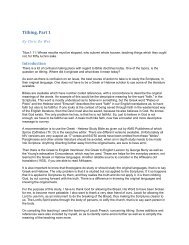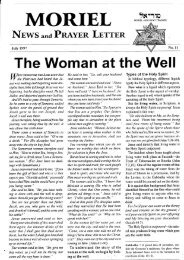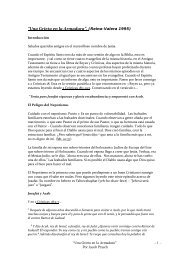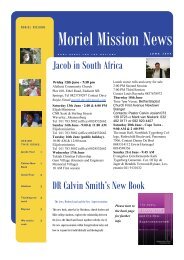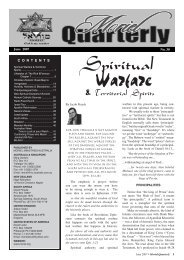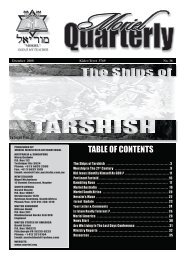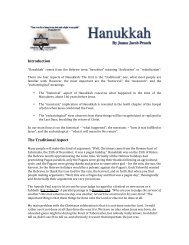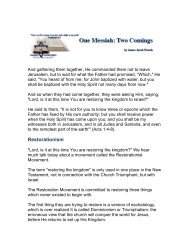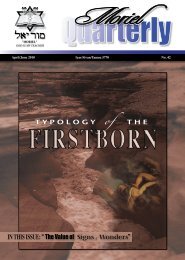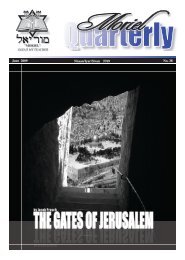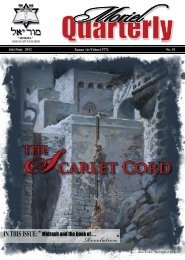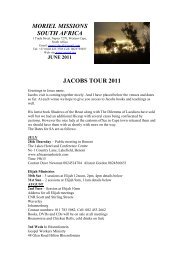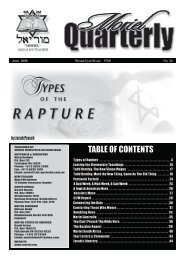The Legacy of Jacob - Moriel Ministries
The Legacy of Jacob - Moriel Ministries
The Legacy of Jacob - Moriel Ministries
You also want an ePaper? Increase the reach of your titles
YUMPU automatically turns print PDFs into web optimized ePapers that Google loves.
Scott Noble<br />
who ruled Kashmir in the eleventh century.”<br />
Of the 40 parallels mentioned above, many<br />
can be dismissed just by making the same<br />
comparisons with people in general or religious<br />
leaders in particular. Items such as they<br />
both fasted for a long time, they were about<br />
the same age when they began public ministry<br />
(Jesus 30; Buddha 35- though Buddha’s age<br />
is debatable here), the multitudes required a<br />
sign from both, both taught compassion both<br />
were <strong>of</strong> royal descent (in the case <strong>of</strong> Buddha<br />
this is debatable), could be said <strong>of</strong> many<br />
people, especially a religious leader.<br />
Thomas (1927) summarizes the work <strong>of</strong><br />
several scholars in this area <strong>of</strong> study: Seydel’s<br />
fifty instances are reduced by van den<br />
Bergh to nine. In proportion to the investigator’s<br />
direct knowledge <strong>of</strong> the Buddhist<br />
sources the number seems to decrease. E.<br />
W. Hopkins discusses five ‘cogent parallels’,<br />
but does not consider any <strong>of</strong> them very probable.<br />
Garbe assumes direct borrowing in four<br />
cases, Simeon, the Temptation, Peter walking<br />
on the sea, and the Miracle <strong>of</strong> the loaves<br />
and fishes. Charpentier considers Simeon<br />
the only unobjectionable example. Other<br />
scholars reject all connexion. In any case the<br />
chief events <strong>of</strong> the life- birth, renunciation,<br />
enlightenment, and the death, the very items<br />
which might give strength to the comparison-<br />
disappear from the question. (247-248)<br />
Rather than going through all <strong>of</strong> these,<br />
I’ll just address some <strong>of</strong> the key ones. In the<br />
case <strong>of</strong> Simeon seeing Jesus at the temple,<br />
and Asita going to see the infant Gautama,<br />
regarding the Buddhist scripture (Nalakasutta<br />
<strong>of</strong> the Sutta-nipata), Thomas says, “It<br />
is clearly late, as is shown by the reference<br />
to the thirty-two marks; and as it is in general<br />
agreement with the Sanskrit accounts,<br />
there is nothing to prove that it is as early<br />
as the pre-Christian era” (39). <strong>The</strong> thirty-two<br />
marks refer to physical characteristics used to<br />
identify a potential Buddha. This is thought<br />
to be a later Mahayana development (K.R.<br />
Norman, 1983, Pali Literature: including the<br />
canonical literature in Prakrit and Sanskrit <strong>of</strong><br />
all the Hinayana schools <strong>of</strong> Buddhism, 42).<br />
James Kennedy (1917), in his article “<strong>The</strong><br />
Gospels <strong>of</strong> the Infancy, the Lalita Vistara and<br />
the Vishnu Purana”, addresses the walking<br />
on water parallel:<br />
<strong>The</strong> story occurs in the introduction to<br />
Jataka No. 190…in this case all we know<br />
is that the story <strong>of</strong> the monk, and the Jataka<br />
which follows it, were considered old<br />
enough to be included among 546 others,<br />
when the Jataka book was compiled in the<br />
fifth or sixth century A.D. (528)<br />
Regarding the multiplying <strong>of</strong> food parallel,<br />
Kennedy writes, “Like the story <strong>of</strong> the<br />
monk we have just discussed, it occurs in the<br />
introduction to a Jataka [No. 78], and is subject<br />
to the same comment” (529).<br />
Another parallel claim made regards the<br />
prodigal son stories <strong>of</strong> Buddha and Jesus. For<br />
an excellent description <strong>of</strong> the content differences<br />
in these stories, please see the following<br />
website: (www.comparativereligion.<br />
com/prodigal.html). This story in Buddhist<br />
scriptures is found in the Saddharmapundarika<br />
sutra. According to the following Buddhist<br />
website, the composition date <strong>of</strong> this<br />
volume is later than the composition <strong>of</strong> Luke<br />
(the gospel in which Jesus tells the story <strong>of</strong><br />
the prodigal son). Luke was Luke’s first volume,<br />
the second being the book <strong>of</strong> Acts (both<br />
<strong>of</strong> which are dated before 63 AD). Here’s the<br />
dating assigned to the Saddharmapundarika<br />
(also known as the “Lotus Sutra”): Contains<br />
elements <strong>of</strong> various eras. <strong>The</strong> final edition<br />
is believed to have taken place around 200<br />
CE, but a lot <strong>of</strong> later interpolations are found<br />
within it. <strong>The</strong> Buddha here is not a historical<br />
figure, but the manifestation <strong>of</strong> an eternal,<br />
abstract ‘Buddhahood’. Further, it contains<br />
the doctrines <strong>of</strong> ‘Expedient Means’ (upaya)<br />
and <strong>of</strong> the ‘One Vehicle’ (ekayana) www.akshin.net/literature/budlitsourcessanskrit.htm<br />
Shin Buddhism (a form <strong>of</strong> Pure Land<br />
Buddhism developed in Japan)<br />
This form <strong>of</strong> Buddhism has been thought<br />
<strong>of</strong> by many to be very similar to Christianity,<br />
because the end goal is a “pure land,” and<br />
achieving that goal is not based on self-effort,<br />
but through the merits <strong>of</strong> Amida Buddha.<br />
<strong>The</strong>re are, however some serious differences<br />
between Christianity and Shin Buddhism.<br />
When seeking out a doctor, people want to be<br />
sure that the doctor’s training has taken place<br />
at a reputable school, that the doctor is basing<br />
the diagnosis on medical facts rather than just<br />
speculation, etc. When it comes to the soul,<br />
how much more important is it to establish<br />
the reliability <strong>of</strong> the source and the content<br />
<strong>of</strong> claims Looking at Shin Buddhism in this<br />
way, there are some serious insufficiencies:<br />
Dharmakara’s credibility: Dharmakara is<br />
said to have been a king who gave up his<br />
throne to become a monk and later became<br />
Amida Buddha. It is claimed he lived approximately<br />
65 billion years ago- using the<br />
time unit <strong>of</strong> a kalpa, which can also be interpreted<br />
as being “inconceivably long” (http://<br />
www.akshin.net/pureland/pl-purelandbuddhism-partone.<br />
htm). If this is the case, why<br />
did he wait until the 2nd century AD (some<br />
say the 2nd century B.C.) to reveal this plan<br />
<strong>of</strong> his pure land It seems rather suspect that<br />
this concept was not developed until after<br />
Siddhartha Gautama made his claims.<br />
Dharmakara’s limitations: Even if we are<br />
to believe this person existed, he was still just<br />
a man, who was preceded by another Buddha,<br />
and who spent approximately 22 billion<br />
years (apparently not as a man at this point),<br />
studying other Buddha lands, in order to<br />
develop his famed “Pure Land.” Already it’s<br />
apparent that he’s not on the same level as<br />
God Almighty as revealed in the Bible.<br />
No atonement: Shin Buddhists place their<br />
faith in Amida Buddha to secure salvation<br />
for them. Unfortunately, this is like trusting<br />
<strong>Moriel</strong> Thailand<br />
a homeless man to pay our million dollar bail<br />
to get out <strong>of</strong> jail. He barely has the means to<br />
sustain himself, let alone get us out <strong>of</strong> the jail<br />
caused by our sins. Anyone with their own<br />
sins to deal with (which is everyone, including<br />
Dharmakara if we are to suppose he existed),<br />
can only take the punishment for their<br />
own sins. Even then though, being imperfect,<br />
this bearing <strong>of</strong> sins can only fulfill justice.<br />
It can’t pay for salvation. Only Jesus, being<br />
God in the flesh, and sinless, could take the<br />
punishment for others.<br />
Shinran’s choice <strong>of</strong> patriarchs (focusing<br />
on the first patriarch): Shinran is the man<br />
who developed Shin Buddhism into what it<br />
is today. He lived in Japan from 1173- 1262<br />
AD. In an attempt to establish authority for<br />
his new interpretation <strong>of</strong> Pure Land, Shinran<br />
chose seven patriarchs: He acknowledged<br />
Sakyamuni Buddha as being the voice <strong>of</strong><br />
Amida Buddha, and then named the first patriarch-<br />
Nagarjuna, a man in India who lived<br />
from c. 150 AD- c. 250 AD . This wide gap<br />
from the time <strong>of</strong> Sakyamuni Buddha, to the<br />
time <strong>of</strong> the first patriarch (500 years, if not<br />
more) shows just how far removed from the<br />
original it is. Also, Nagarjuna is said to have<br />
had interactions with giant snakes, just as<br />
Sakyamuni encountered Mucalinda:<br />
Mahayana tradition explains the chronological<br />
discrepancy by contending that they<br />
were indeed taught by the Buddha to advanced<br />
disciples, but that he ordered that<br />
they be hidden in the underwater realm <strong>of</strong><br />
nagas (beings with snakelike bodies and human<br />
heads) until the time was right for their<br />
propagation. <strong>The</strong> legend further reports that<br />
the second-century philosopher Nagarjuna<br />
(fl. ca. 150 C.E.) was the person preordained<br />
by Buddha to recover and explicate the Perfection<br />
<strong>of</strong> Wisdom texts.<br />
After one <strong>of</strong> his lectures, some nagas approached<br />
him and told him <strong>of</strong> the texts hidden<br />
in their kingdom, and so Nagarjuna traveled<br />
there and returned with the sutras to India.<br />
This is a man who was taught by giant<br />
snakes! How can we entrust ourselves to such<br />
teachings What parents would leave their<br />
baby in the care <strong>of</strong> a cobra Half <strong>of</strong> Nagarjuna’s<br />
name is <strong>of</strong> Hindu origin, and the other half<br />
comes from his interactions with these nagas:<br />
When he preached the Dharma in the<br />
monastery park, the nagas performed acts <strong>of</strong><br />
reverence such as six <strong>of</strong> the serpents forming<br />
a parasol to shade him from the sun. Having<br />
thus become the Lord <strong>of</strong> the Nagas, the<br />
Acarya was named “<strong>The</strong> Naga”. Because his<br />
skill at spreading the Mahayana Dharma resembled<br />
the shooting speed and mastery <strong>of</strong><br />
the famed archer Arjuna, he became known<br />
as well as “<strong>The</strong> Arjuna”<br />
Shin Buddhism’s scriptures: Shin Buddhism<br />
is based on the writings <strong>of</strong> the seven<br />
patriarchs, as well as on the three primary<br />
texts: scriptures <strong>of</strong> this tradition [Pure Land<br />
in general] (which later became known as<br />
the Triple Sutras) appeared during the ini-<br />
March 2012 • <strong>Moriel</strong> Quarterly 25




